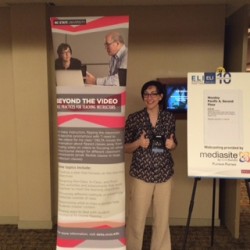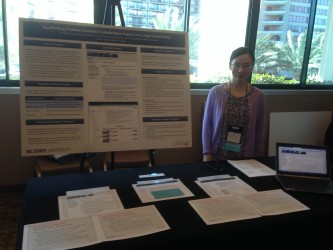An Overview of ELI 2015
By Ashley Grantham with co-authors Emily Ligon and Yan Shen. Dan Dunnagan, Cathi Dunnagan, Amanda Robertson, Chrissie Van Hoever, and Steve Bader also contributed.
In February, I had the opportunity to attend the ELI Annual Meeting in Anaheim, California along with fellow DELTA team members Emily Ligon, Steve Bader, Amanda Robertson, Yan Shen, Chrissie Van Hoever, Cathi Dunnagan, Dan Dunnagan, and Ed Lindsay, a faculty member in Parks, Recreation, and Tourism Management. This year’s theme was Designing our thinking: Crafting new directions for digital engagement. Over the course of three days, we attended many sessions focused on innovations in the field and best practices in supporting faculty in teaching with technology.
Emily and I had the pleasure of presenting a three-hour preconference seminar called “Beyond the video: Best practices for teaching instructors how to design a flipped course.” During the seminar, we shared our approach for helping faculty members through the course design process for a flipped classroom that puts the emphasis on whole-lesson design and learning objective creation rather than video production in terms of time and importance. We built in many opportunities for small- and large-group discussion, and enjoyed getting to hear how faculty development work varies and is similar across campuses.
Emily also presented a poster titled “Flipping a 300-Student Accounting Class: Challenges, Solutions, Iterations, and Implementations.” Based on the effort from a Large Course Redesign Grant (now Critical Path Course Redesign Grant), the poster highlighted the iterative nature of the analysis, design, development, and evaluation of course redesign and effectively using student and instructor feedback to implement solutions that match instructor teaching preferences and increase student learning outcomes at the same time.
Yan Shen’s presentation on “Scaffolding Problem-Centered Collaborative Inquiry in a Large Online Class” originated from the 2012-2013 Exploratory IDEA Grant on WGS 210: Women and Gender in Science and Technology, a collaborative effort with Deena Murphy as the instructor and David Tredwell as the new media developer. She had the opportunity to present this topic through three different venues: a virtual pre-conference seminar, a TED-style presentation, and a poster presentation. In each session, she introduced the course context, discussed the instructional challenges, and demonstrated examples of technology scaffolding, peer scaffolding, and instructor scaffolding. She also shared evaluation results regarding the effectiveness of the scaffolding design and generalized design strategies that could be applied to different course contexts.
President and CEO of EDUCAUSE Diana Oblinger gave a presentation titled “Designed to engage” in which she encouraged the audience to think about the potential of technology to positively impact student success that I found to be very engaging. From advising systems to alternative credentialing to the digital humanities, Oblinger urged participants to consider how technology can be used to create richer interactions between faculty and students, to empower learners, and benefit students by helping them pinpoint problem areas in their academic journeys as well as offer them suggestions for success.
Dr. Peter Doolittle, assistant provost for teaching and learning, executive director of the Center for Instructional Development and Educational Research, and professor of educational psychology at Virginia Tech, gave a keynote presentation titled “From silver bullets to first principles: Effectively leveraging technology in higher education”. During the presentation, he compared technology determinism with social determinism and cautioned people in our field not to let technology determine or control education but let humans decide how technology should be used to support education. He provided three questions to help distinguish pedagogically meaningful technology from silver bullet technology: Where is research? Where is processing? Where is the design? Mature adoptions of technology usually have existing research about learning outcomes, can support cognitive, behavioral, affective, or social processings, and have learning objectives, engagement, activities, artifacts, and assessments.
I really enjoyed how many of the sessions used innovative teaching strategies to present content about advances in teaching and learning with technology. Representing EDUCAUSE, D. Christopher Brooks and Eden Dahlstrom led participants in an engaging 45-minute game show style presentation to share the results of the most recent Study of Higher Education Faculty and Information Technology survey. (Our own Amanda Robertson won the game and received a floppy disk trophy for her efforts.) In addition to it being a really fun way to hear survey results, I had a lot of great takeaways from this session. One of the most interesting findings from the study was faculty stating that the number one factor motivating them to further integrate technology into their teaching was clear evidence that students would benefit.
Another interesting session that used innovative teaching strategies to present content about advances in teaching and learning with technology involved games and Twitter to create an unfolding student-generated narrative. Pete Rorabough, Southern Polytechnic University, and Andrea Rehn, Whittier College, led participants through the game #TvsZ, a massive open online game. Emily Ligon, Cathi Dunnagan, and Chrissie Van Hoever attended the session and had to determine if nature or technology would save the world while creating narratives describing what the world looked like and how nature and technology functioned within it. Because the game is played on Twitter, there was a learning curve to be able to participate and the experience was disorienting to those new to the social media platform. The experience was valuable because it demonstrated the need for proper orientation and scaffolding to introduce this experience to students while also showing the ability of the game to promote collaborative learning and creative thinking.
While we attended a lot of great sessions (some alongside telepresence robots!), we also made a little time for fun and enjoyed spending time at Disneyland with colleagues. Overall, the conference was a great success, and I look forward to being able to attend in the future.
- Categories:




